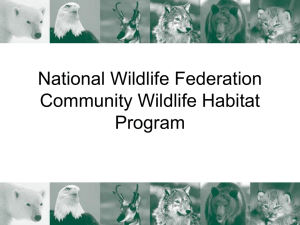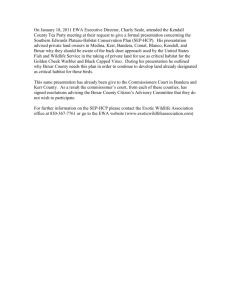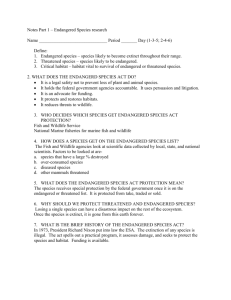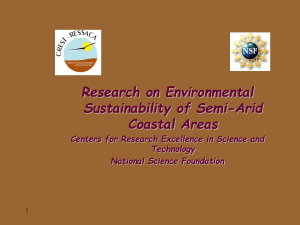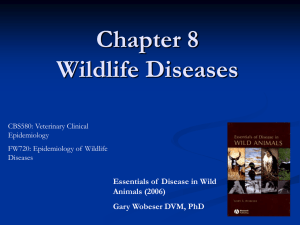View Document - Northwest Power & Conservation Council
advertisement
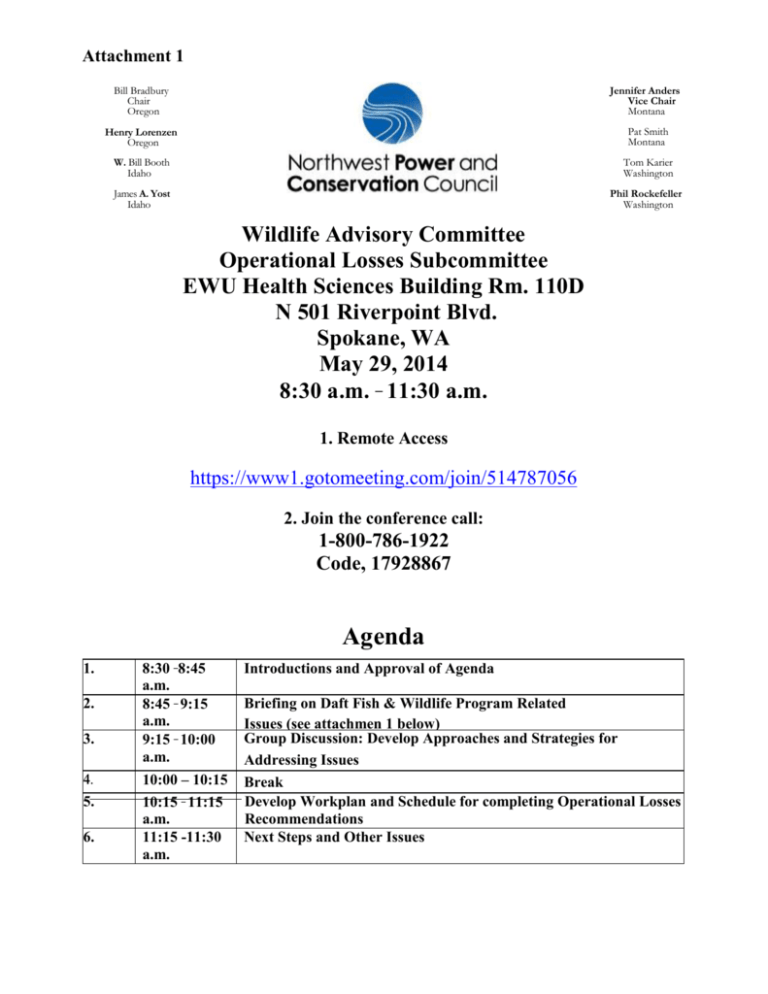
Attachment 1 Bill Bradbury Chair Oregon Jennifer Anders Vice Chair Montana Henry Lorenzen Oregon Pat Smith Montana W. Bill Booth Idaho Tom Karier Washington James A. Yost Idaho Phil Rockefeller Washington Wildlife Advisory Committee Operational Losses Subcommittee EWU Health Sciences Building Rm. 110D N 501 Riverpoint Blvd. Spokane, WA May 29, 2014 8:30 a.m. – 11:30 a.m. 1. Remote Access https://www1.gotomeeting.com/join/514787056 2. Join the conference call: 1-800-786-1922 Code, 17928867 Agenda 1. 2. 3. 4. 5. 6. 8:30 –8:45 Introductions and Approval of Agenda a.m. Briefing on Daft Fish & Wildlife Program Related 8:45 – 9:15 a.m. Issues (see attachmen 1 below) Group Discussion: Develop Approaches and Strategies for 9:15 – 10:00 addressing a.m. Addressing Issues 10:00 – 10:15 Break a.m 10:15 – 11:15 Develop Workplan and Schedule for completing Operational Losses Rec a.m. Recommendations 11:15 -11:30 Next Steps and Other Issues a.m. Attachment 1 Draft Columbia River Fish & Wildlife Program – Wildlife mitigation Section (See Yellow Highlights on Operational Losses) Sub-strategy Mitigate wildlife losses caused by the development and operation of hydropower dams in the Columbia River Basin. Rationale Development and operation of the hydrosystem resulted in wildlife losses, operational losses, and secondary losses. The program includes measures and implements projects to acquire and protect the habitat units identified in the loss assessments [see Appendix C-4], as mitigation for construction and inundation losses. The program maintains a commitment to mitigate for operational and secondary losses that have not been estimated or addressed. However, where operational or secondary losses already have been addressed in an existing wildlife mitigation agreement, the terms of that agreement will apply. Principles The extent of wildlife mitigation is of particular importance to agencies and tribes in blocked areas, where anadromous fish runs have been extirpated by development of the hydrosystem, and where full mitigation cannot be accomplished through resident fish substitution alone. Given the vision of this program, the strong scientific case for a more comprehensive, ecosystem-based approach, and the shift in focus to implementation through subbasin plans, the Council believes that wildlife mitigation projects should be integrated with the fish mitigation projects as much as possible and in some cases, where resident fish goals cannot be accomplished, wildlife mitigation may substitute for resident fish mitigation. Wildlife mitigation should replace habitat units lost to hydropower dam development and operation. Beginning in the 2000 Program, the Council called for these mitigation agreements to equal 200 percent of the remaining habitat units (2:1 ratio). The Council chose the 2:1 crediting ratio to address the inability to precisely determine the habitat units resulting from acquiring an interest in property that already has wildlife value or the additional losses represented by annualization of the losses. The Council adopted and continues to endorse the 2:1 crediting ratio for the remaining habitat units. However, when loss estimates appear inaccurate due to habitat unit stacking and those inaccuracies cannot be resolved through use of a different, costeffective tool or approach recommended by the Wildlife Crediting Forum and approved by the Council, then the 2:1 ratio will not apply to the remaining stacked habitat units. Mitigation agreements should be considered to settle operational losses in lieu of precise assessments of impacts. General measures Where appropriate prioritization exists and agreements exist on the methodology, complete wildlife loss assessments for losses caused by operation of the hydropower projects Develop and implement habitat acquisition and enhancement projects to fully mitigate for identified losses Attachment 1 Coordinate habitat restoration and acquisition activities throughout the basin with fish mitigation and restoration efforts to promote terrestrial and aquatic area connectivity Maintain the values and characteristics of existing, restored, and created habitat The Council encourages wildlife managers to monitor and evaluate habitat and species responses to mitigation actions Bonneville and the fish and wildlife managers shall complete wildlife loss mitigation agreements for at least the remaining construction and inundation losses by 2016. In addition, for each wildlife agreement that does not already provide for long-term maintenance of the habitat, Bonneville and the applicable management agency shall propose a management plan adequate to sustain the minimum credited habitat values for the life of the project. Fish and wildlife managers and Bonneville shall reach agreement on how wildlife mitigation projects and fish mitigation projects should be credited toward identified losses Specific measures for habitat units: Habitat units and the habitat evaluation procedure (HEP) methodology The Council shall continue to endorse habitat units as the preferred unit of measurement for mitigation accounting and the Habitat Evaluation Procedure methodology as the preferred method for estimating habitat units lost and acquired. Parties to a wildlife mitigation agreement may develop and use another method for evaluating potential mitigation actions if, in the Council’s opinion, that alternative method adequately takes into account both habitat quantity and quality adequate to mitigate for the identified losses. Allocation of habitat units Habitat acquired as mitigation for lost habitat units identified in Table C-4 shall be acquired in the subbasin in which the lost units were located unless otherwise agreed by the fish and wildlife agencies and tribes in that subbasin. Habitat enhancement credits Habitat enhancement credits should be provided to Bonneville when habitat management activities funded by Bonneville lead to a net increase in habitat value when compared to the level identified in the baseline habitat inventory and subsequent habitat inventories. This determination shall be made through the periodic monitoring of the project site using the Habitat Evaluation Procedure methodology. Bonneville shall be credited for habitat enhancement efforts at a ratio of one habitat unit credited for every habitat unit gained. Long-term agreements Whenever possible, wildlife mitigation shall take place through long-term agreements that have clear objectives, a plan for action over time, a committed level of funding that provides a substantial likelihood of achieving and sustaining the stated wildlife mitigation objectives, and provisions to ensure effective implementation with periodic monitoring and evaluation. Thus, wildlife mitigation agreements shall include the following elements: Measurable objectives, including acres of habitat types and number of habitat units by species to be acquired, and a statement estimating the contribution to addressing the wildlife losses identified in Table C-4 in the Appendix Demonstration of consistency with the wildlife policies, objectives, and strategies in the Council’s program, including with the implementation priorities described in Tables C-1, C-2, and C-3 in the Appendix Adherence to the open and public process language found in the Northwest Power Act including measures to address concerns over additions to public land ownership and Attachment 1 impacts on local communities, such as a reduction or loss of local government tax base or the local economic base and consistency with local governments’ comprehensive plans When possible, protection for riparian habitat that can benefit both fish and wildlife, and protect high-quality native habitat and species of special concern, including endangered, threatened, or sensitive species Incentives to ensure effective implementation of the agreement, plan or action, with periodic monitoring and evaluation (including a periodic audit) and reporting of results. At a minimum, annual reports to Pisces must continue in order for the Council to evaluate the mitigation benefits. Provisions for funding long-term maintenance of the habitat adequate to sustain the minimum credited habitat values for the life of the project to achieve and sustain the wildlife mitigation objectives For a project to be credited against construction and inundation losses it must be consistent with the Fish and Wildlife Program. Criteria include: o Covenants, easements, fee title acquisitions or other appropriate agreements for the life of the hydroelectric project to ensure project areas are permanently protected and dedicated to wildlife benefits o A demonstration that projects will benefit priority wildlife habitat, species, or populations as defined by federal, state, or tribal wildlife management plans or subbasin plans o A completed project-area management plan o A long-term funding agreement adequate to support implementation of the management plan Link to subbasin plans See the Council’s subbasin plans for subbasin-level information pertaining to wildlife focal species and management strategies that help guide project selection. Link to resolving uncertainties and tracking progress Wildlife Advisory Committee The Council recognizes the ongoing difficulties in addressing wildlife operational losses. At the same time the Council recognizes the progress that has been made in addressing this issue as the result of pilot projects on the Kootenai River. To address this issue the Council has directed its Wildlife Advisory Committee to examine the existing options and alternatives for providing mitigation for wildlife operational losses and to provide a recommendation to the Council for resolving the issue by October 1, 2015. In addition, the committee has been charged to make recommendations on the following issues: The need for additional HEP reports and future HEP Team funding The diminishing need for HEP on new acquisitions as Bonneville completes construction and inundation mitigation Current regional need for follow-up HEP capacity to track project agreement compliance on many properties. That need may be influenced by 1) long-term settlements for operation and maintenance, 2) technology advances that may allow the region to more cost effectively track changes in habitat conditions using remote sensing or other techniques, and 3) species responses. The need for new methods to assess operational losses that incorporate the results of ongoing pilot projects. This could include technical testing and evaluation of operational loss models and methodologies, or other alternative habitat evaluation methods. Attachment 1


